Written Assessment Case Study 2022
VerifiedAdded on 2022/10/04
|11
|2688
|15
AI Summary
Contribute Materials
Your contribution can guide someone’s learning journey. Share your
documents today.
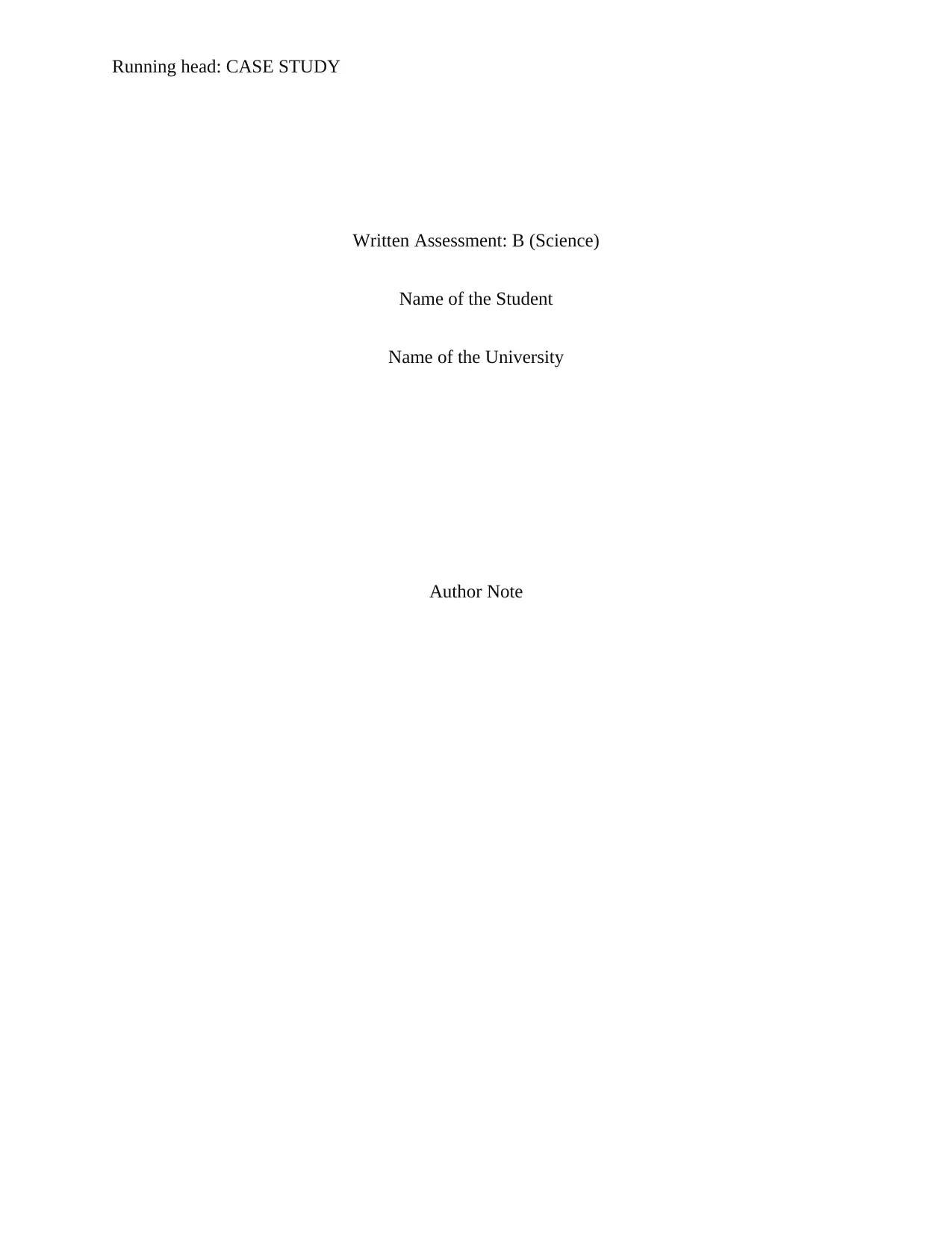
Running head: CASE STUDY
Written Assessment: B (Science)
Name of the Student
Name of the University
Author Note
Written Assessment: B (Science)
Name of the Student
Name of the University
Author Note
Secure Best Marks with AI Grader
Need help grading? Try our AI Grader for instant feedback on your assignments.
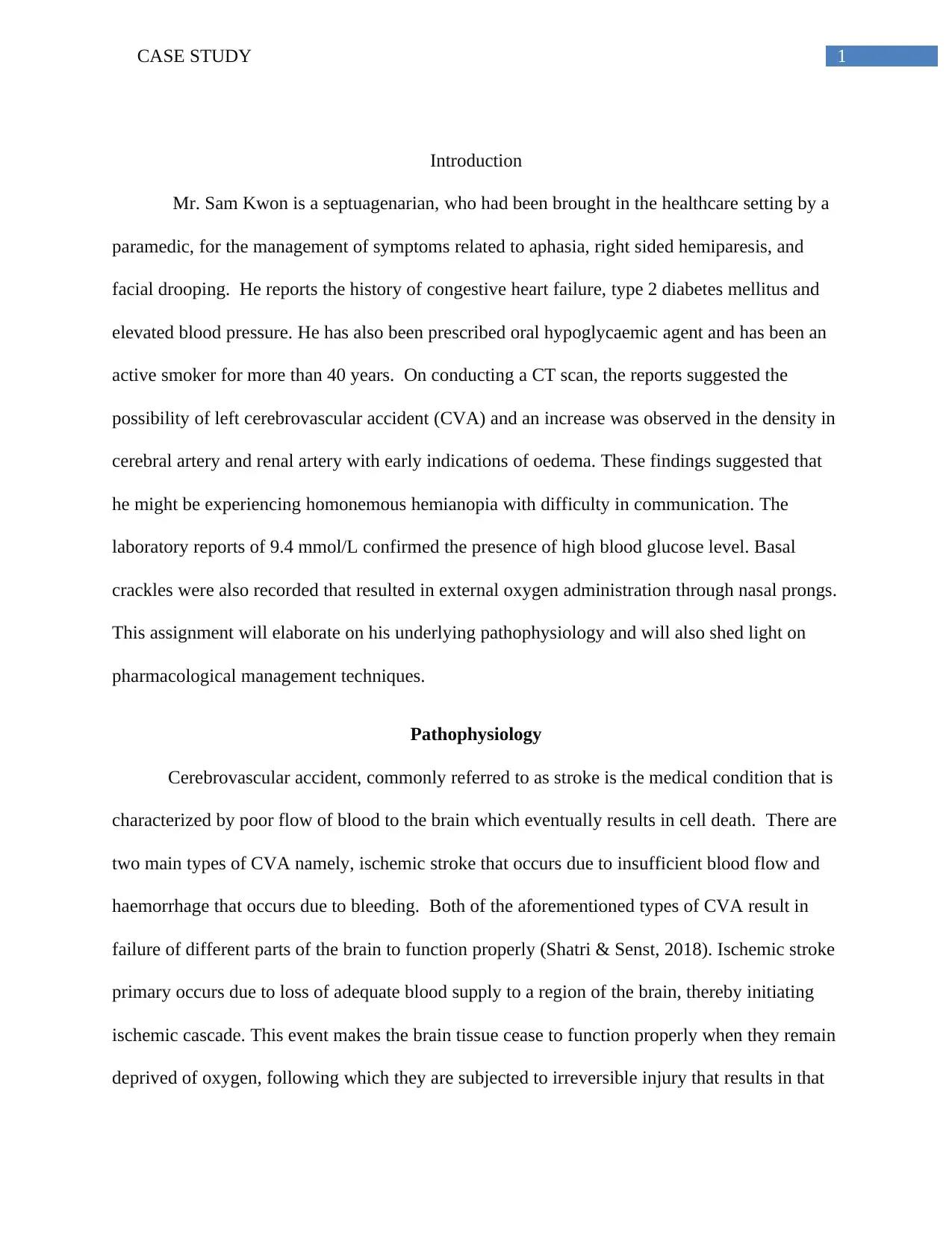
1CASE STUDY
Introduction
Mr. Sam Kwon is a septuagenarian, who had been brought in the healthcare setting by a
paramedic, for the management of symptoms related to aphasia, right sided hemiparesis, and
facial drooping. He reports the history of congestive heart failure, type 2 diabetes mellitus and
elevated blood pressure. He has also been prescribed oral hypoglycaemic agent and has been an
active smoker for more than 40 years. On conducting a CT scan, the reports suggested the
possibility of left cerebrovascular accident (CVA) and an increase was observed in the density in
cerebral artery and renal artery with early indications of oedema. These findings suggested that
he might be experiencing homonemous hemianopia with difficulty in communication. The
laboratory reports of 9.4 mmol/L confirmed the presence of high blood glucose level. Basal
crackles were also recorded that resulted in external oxygen administration through nasal prongs.
This assignment will elaborate on his underlying pathophysiology and will also shed light on
pharmacological management techniques.
Pathophysiology
Cerebrovascular accident, commonly referred to as stroke is the medical condition that is
characterized by poor flow of blood to the brain which eventually results in cell death. There are
two main types of CVA namely, ischemic stroke that occurs due to insufficient blood flow and
haemorrhage that occurs due to bleeding. Both of the aforementioned types of CVA result in
failure of different parts of the brain to function properly (Shatri & Senst, 2018). Ischemic stroke
primary occurs due to loss of adequate blood supply to a region of the brain, thereby initiating
ischemic cascade. This event makes the brain tissue cease to function properly when they remain
deprived of oxygen, following which they are subjected to irreversible injury that results in that
Introduction
Mr. Sam Kwon is a septuagenarian, who had been brought in the healthcare setting by a
paramedic, for the management of symptoms related to aphasia, right sided hemiparesis, and
facial drooping. He reports the history of congestive heart failure, type 2 diabetes mellitus and
elevated blood pressure. He has also been prescribed oral hypoglycaemic agent and has been an
active smoker for more than 40 years. On conducting a CT scan, the reports suggested the
possibility of left cerebrovascular accident (CVA) and an increase was observed in the density in
cerebral artery and renal artery with early indications of oedema. These findings suggested that
he might be experiencing homonemous hemianopia with difficulty in communication. The
laboratory reports of 9.4 mmol/L confirmed the presence of high blood glucose level. Basal
crackles were also recorded that resulted in external oxygen administration through nasal prongs.
This assignment will elaborate on his underlying pathophysiology and will also shed light on
pharmacological management techniques.
Pathophysiology
Cerebrovascular accident, commonly referred to as stroke is the medical condition that is
characterized by poor flow of blood to the brain which eventually results in cell death. There are
two main types of CVA namely, ischemic stroke that occurs due to insufficient blood flow and
haemorrhage that occurs due to bleeding. Both of the aforementioned types of CVA result in
failure of different parts of the brain to function properly (Shatri & Senst, 2018). Ischemic stroke
primary occurs due to loss of adequate blood supply to a region of the brain, thereby initiating
ischemic cascade. This event makes the brain tissue cease to function properly when they remain
deprived of oxygen, following which they are subjected to irreversible injury that results in that
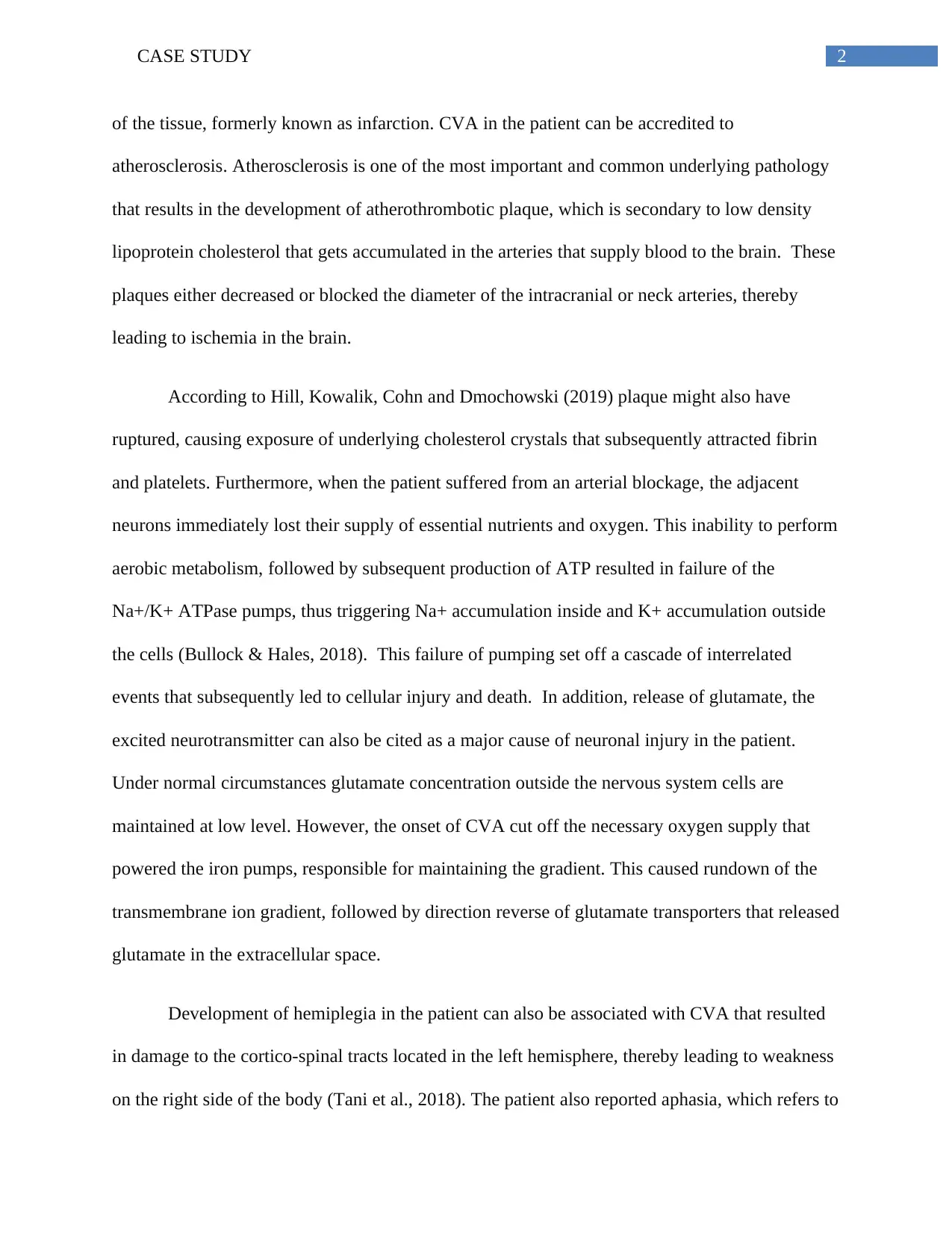
2CASE STUDY
of the tissue, formerly known as infarction. CVA in the patient can be accredited to
atherosclerosis. Atherosclerosis is one of the most important and common underlying pathology
that results in the development of atherothrombotic plaque, which is secondary to low density
lipoprotein cholesterol that gets accumulated in the arteries that supply blood to the brain. These
plaques either decreased or blocked the diameter of the intracranial or neck arteries, thereby
leading to ischemia in the brain.
According to Hill, Kowalik, Cohn and Dmochowski (2019) plaque might also have
ruptured, causing exposure of underlying cholesterol crystals that subsequently attracted fibrin
and platelets. Furthermore, when the patient suffered from an arterial blockage, the adjacent
neurons immediately lost their supply of essential nutrients and oxygen. This inability to perform
aerobic metabolism, followed by subsequent production of ATP resulted in failure of the
Na+/K+ ATPase pumps, thus triggering Na+ accumulation inside and K+ accumulation outside
the cells (Bullock & Hales, 2018). This failure of pumping set off a cascade of interrelated
events that subsequently led to cellular injury and death. In addition, release of glutamate, the
excited neurotransmitter can also be cited as a major cause of neuronal injury in the patient.
Under normal circumstances glutamate concentration outside the nervous system cells are
maintained at low level. However, the onset of CVA cut off the necessary oxygen supply that
powered the iron pumps, responsible for maintaining the gradient. This caused rundown of the
transmembrane ion gradient, followed by direction reverse of glutamate transporters that released
glutamate in the extracellular space.
Development of hemiplegia in the patient can also be associated with CVA that resulted
in damage to the cortico-spinal tracts located in the left hemisphere, thereby leading to weakness
on the right side of the body (Tani et al., 2018). The patient also reported aphasia, which refers to
of the tissue, formerly known as infarction. CVA in the patient can be accredited to
atherosclerosis. Atherosclerosis is one of the most important and common underlying pathology
that results in the development of atherothrombotic plaque, which is secondary to low density
lipoprotein cholesterol that gets accumulated in the arteries that supply blood to the brain. These
plaques either decreased or blocked the diameter of the intracranial or neck arteries, thereby
leading to ischemia in the brain.
According to Hill, Kowalik, Cohn and Dmochowski (2019) plaque might also have
ruptured, causing exposure of underlying cholesterol crystals that subsequently attracted fibrin
and platelets. Furthermore, when the patient suffered from an arterial blockage, the adjacent
neurons immediately lost their supply of essential nutrients and oxygen. This inability to perform
aerobic metabolism, followed by subsequent production of ATP resulted in failure of the
Na+/K+ ATPase pumps, thus triggering Na+ accumulation inside and K+ accumulation outside
the cells (Bullock & Hales, 2018). This failure of pumping set off a cascade of interrelated
events that subsequently led to cellular injury and death. In addition, release of glutamate, the
excited neurotransmitter can also be cited as a major cause of neuronal injury in the patient.
Under normal circumstances glutamate concentration outside the nervous system cells are
maintained at low level. However, the onset of CVA cut off the necessary oxygen supply that
powered the iron pumps, responsible for maintaining the gradient. This caused rundown of the
transmembrane ion gradient, followed by direction reverse of glutamate transporters that released
glutamate in the extracellular space.
Development of hemiplegia in the patient can also be associated with CVA that resulted
in damage to the cortico-spinal tracts located in the left hemisphere, thereby leading to weakness
on the right side of the body (Tani et al., 2018). The patient also reported aphasia, which refers to
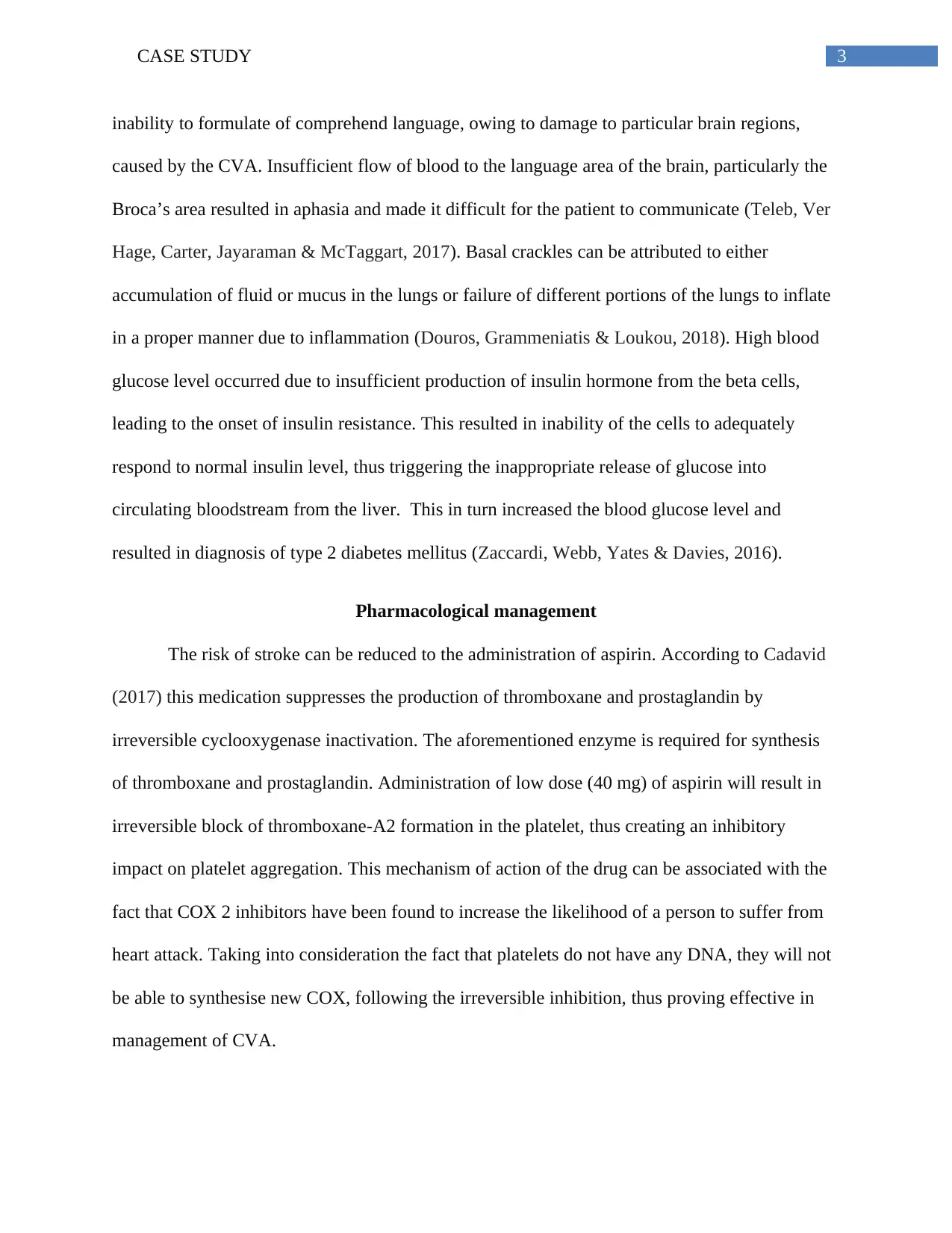
3CASE STUDY
inability to formulate of comprehend language, owing to damage to particular brain regions,
caused by the CVA. Insufficient flow of blood to the language area of the brain, particularly the
Broca’s area resulted in aphasia and made it difficult for the patient to communicate (Teleb, Ver
Hage, Carter, Jayaraman & McTaggart, 2017). Basal crackles can be attributed to either
accumulation of fluid or mucus in the lungs or failure of different portions of the lungs to inflate
in a proper manner due to inflammation (Douros, Grammeniatis & Loukou, 2018). High blood
glucose level occurred due to insufficient production of insulin hormone from the beta cells,
leading to the onset of insulin resistance. This resulted in inability of the cells to adequately
respond to normal insulin level, thus triggering the inappropriate release of glucose into
circulating bloodstream from the liver. This in turn increased the blood glucose level and
resulted in diagnosis of type 2 diabetes mellitus (Zaccardi, Webb, Yates & Davies, 2016).
Pharmacological management
The risk of stroke can be reduced to the administration of aspirin. According to Cadavid
(2017) this medication suppresses the production of thromboxane and prostaglandin by
irreversible cyclooxygenase inactivation. The aforementioned enzyme is required for synthesis
of thromboxane and prostaglandin. Administration of low dose (40 mg) of aspirin will result in
irreversible block of thromboxane-A2 formation in the platelet, thus creating an inhibitory
impact on platelet aggregation. This mechanism of action of the drug can be associated with the
fact that COX 2 inhibitors have been found to increase the likelihood of a person to suffer from
heart attack. Taking into consideration the fact that platelets do not have any DNA, they will not
be able to synthesise new COX, following the irreversible inhibition, thus proving effective in
management of CVA.
inability to formulate of comprehend language, owing to damage to particular brain regions,
caused by the CVA. Insufficient flow of blood to the language area of the brain, particularly the
Broca’s area resulted in aphasia and made it difficult for the patient to communicate (Teleb, Ver
Hage, Carter, Jayaraman & McTaggart, 2017). Basal crackles can be attributed to either
accumulation of fluid or mucus in the lungs or failure of different portions of the lungs to inflate
in a proper manner due to inflammation (Douros, Grammeniatis & Loukou, 2018). High blood
glucose level occurred due to insufficient production of insulin hormone from the beta cells,
leading to the onset of insulin resistance. This resulted in inability of the cells to adequately
respond to normal insulin level, thus triggering the inappropriate release of glucose into
circulating bloodstream from the liver. This in turn increased the blood glucose level and
resulted in diagnosis of type 2 diabetes mellitus (Zaccardi, Webb, Yates & Davies, 2016).
Pharmacological management
The risk of stroke can be reduced to the administration of aspirin. According to Cadavid
(2017) this medication suppresses the production of thromboxane and prostaglandin by
irreversible cyclooxygenase inactivation. The aforementioned enzyme is required for synthesis
of thromboxane and prostaglandin. Administration of low dose (40 mg) of aspirin will result in
irreversible block of thromboxane-A2 formation in the platelet, thus creating an inhibitory
impact on platelet aggregation. This mechanism of action of the drug can be associated with the
fact that COX 2 inhibitors have been found to increase the likelihood of a person to suffer from
heart attack. Taking into consideration the fact that platelets do not have any DNA, they will not
be able to synthesise new COX, following the irreversible inhibition, thus proving effective in
management of CVA.
Secure Best Marks with AI Grader
Need help grading? Try our AI Grader for instant feedback on your assignments.
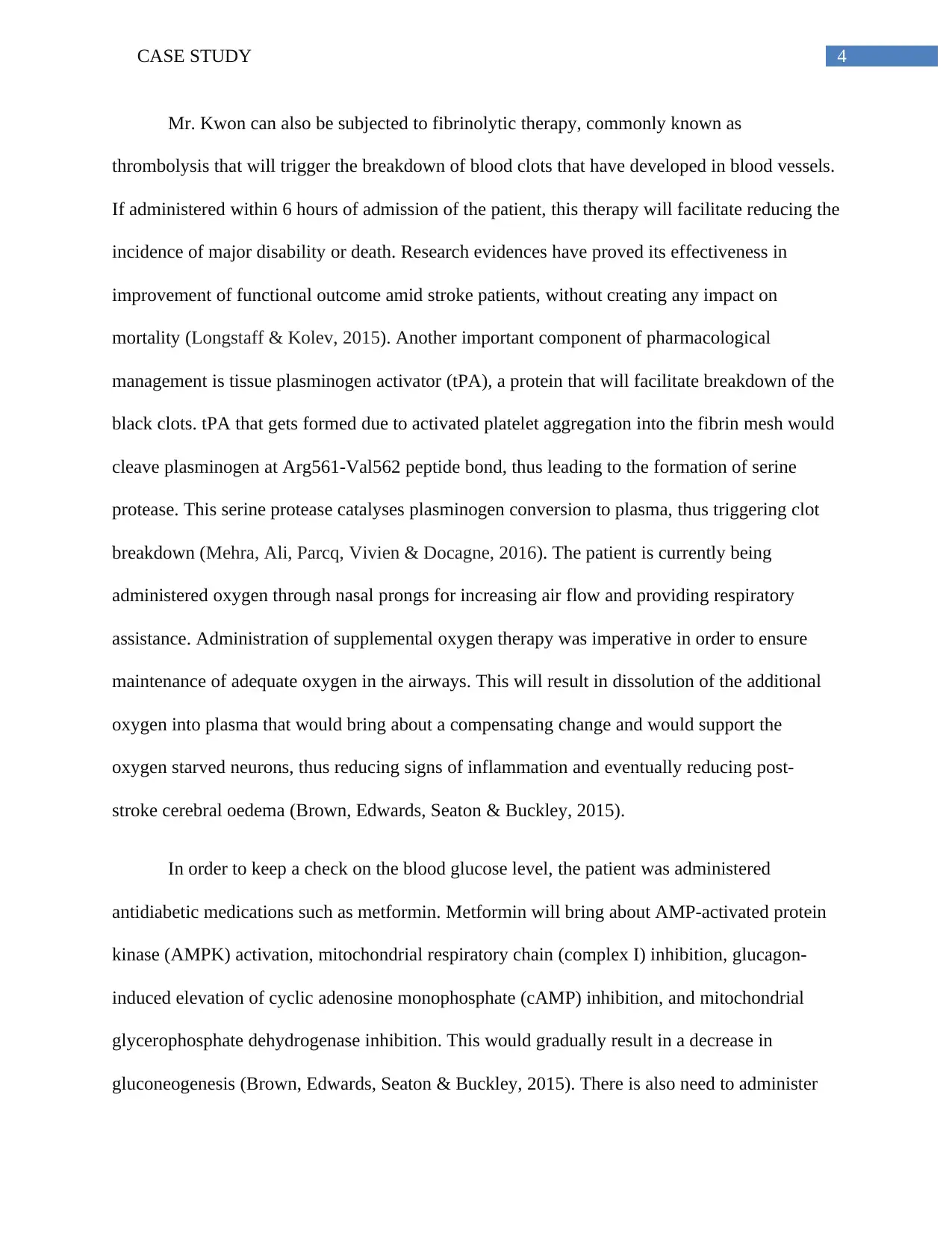
4CASE STUDY
Mr. Kwon can also be subjected to fibrinolytic therapy, commonly known as
thrombolysis that will trigger the breakdown of blood clots that have developed in blood vessels.
If administered within 6 hours of admission of the patient, this therapy will facilitate reducing the
incidence of major disability or death. Research evidences have proved its effectiveness in
improvement of functional outcome amid stroke patients, without creating any impact on
mortality (Longstaff & Kolev, 2015). Another important component of pharmacological
management is tissue plasminogen activator (tPA), a protein that will facilitate breakdown of the
black clots. tPA that gets formed due to activated platelet aggregation into the fibrin mesh would
cleave plasminogen at Arg561-Val562 peptide bond, thus leading to the formation of serine
protease. This serine protease catalyses plasminogen conversion to plasma, thus triggering clot
breakdown (Mehra, Ali, Parcq, Vivien & Docagne, 2016). The patient is currently being
administered oxygen through nasal prongs for increasing air flow and providing respiratory
assistance. Administration of supplemental oxygen therapy was imperative in order to ensure
maintenance of adequate oxygen in the airways. This will result in dissolution of the additional
oxygen into plasma that would bring about a compensating change and would support the
oxygen starved neurons, thus reducing signs of inflammation and eventually reducing post-
stroke cerebral oedema (Brown, Edwards, Seaton & Buckley, 2015).
In order to keep a check on the blood glucose level, the patient was administered
antidiabetic medications such as metformin. Metformin will bring about AMP-activated protein
kinase (AMPK) activation, mitochondrial respiratory chain (complex I) inhibition, glucagon-
induced elevation of cyclic adenosine monophosphate (cAMP) inhibition, and mitochondrial
glycerophosphate dehydrogenase inhibition. This would gradually result in a decrease in
gluconeogenesis (Brown, Edwards, Seaton & Buckley, 2015). There is also need to administer
Mr. Kwon can also be subjected to fibrinolytic therapy, commonly known as
thrombolysis that will trigger the breakdown of blood clots that have developed in blood vessels.
If administered within 6 hours of admission of the patient, this therapy will facilitate reducing the
incidence of major disability or death. Research evidences have proved its effectiveness in
improvement of functional outcome amid stroke patients, without creating any impact on
mortality (Longstaff & Kolev, 2015). Another important component of pharmacological
management is tissue plasminogen activator (tPA), a protein that will facilitate breakdown of the
black clots. tPA that gets formed due to activated platelet aggregation into the fibrin mesh would
cleave plasminogen at Arg561-Val562 peptide bond, thus leading to the formation of serine
protease. This serine protease catalyses plasminogen conversion to plasma, thus triggering clot
breakdown (Mehra, Ali, Parcq, Vivien & Docagne, 2016). The patient is currently being
administered oxygen through nasal prongs for increasing air flow and providing respiratory
assistance. Administration of supplemental oxygen therapy was imperative in order to ensure
maintenance of adequate oxygen in the airways. This will result in dissolution of the additional
oxygen into plasma that would bring about a compensating change and would support the
oxygen starved neurons, thus reducing signs of inflammation and eventually reducing post-
stroke cerebral oedema (Brown, Edwards, Seaton & Buckley, 2015).
In order to keep a check on the blood glucose level, the patient was administered
antidiabetic medications such as metformin. Metformin will bring about AMP-activated protein
kinase (AMPK) activation, mitochondrial respiratory chain (complex I) inhibition, glucagon-
induced elevation of cyclic adenosine monophosphate (cAMP) inhibition, and mitochondrial
glycerophosphate dehydrogenase inhibition. This would gradually result in a decrease in
gluconeogenesis (Brown, Edwards, Seaton & Buckley, 2015). There is also need to administer
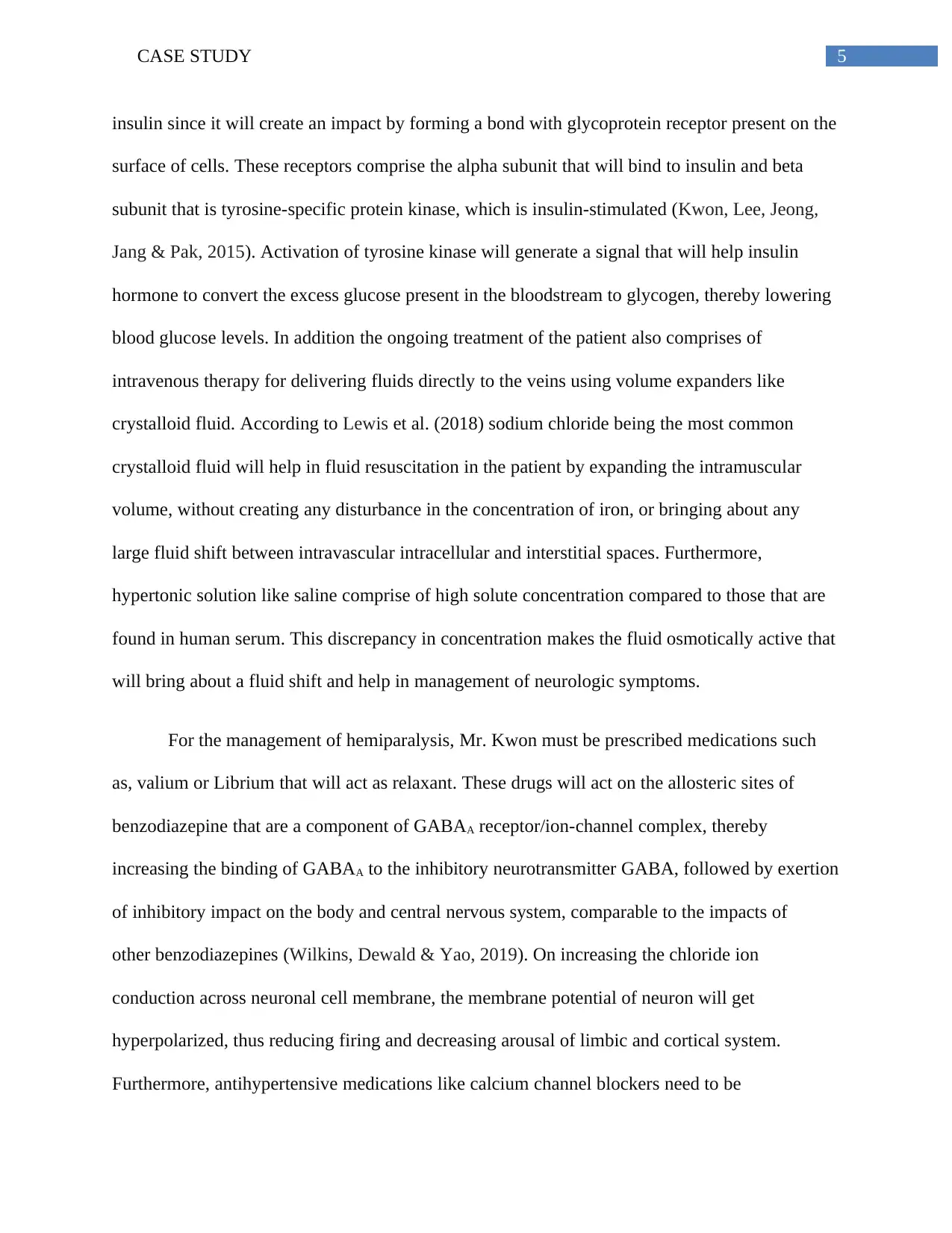
5CASE STUDY
insulin since it will create an impact by forming a bond with glycoprotein receptor present on the
surface of cells. These receptors comprise the alpha subunit that will bind to insulin and beta
subunit that is tyrosine-specific protein kinase, which is insulin-stimulated (Kwon, Lee, Jeong,
Jang & Pak, 2015). Activation of tyrosine kinase will generate a signal that will help insulin
hormone to convert the excess glucose present in the bloodstream to glycogen, thereby lowering
blood glucose levels. In addition the ongoing treatment of the patient also comprises of
intravenous therapy for delivering fluids directly to the veins using volume expanders like
crystalloid fluid. According to Lewis et al. (2018) sodium chloride being the most common
crystalloid fluid will help in fluid resuscitation in the patient by expanding the intramuscular
volume, without creating any disturbance in the concentration of iron, or bringing about any
large fluid shift between intravascular intracellular and interstitial spaces. Furthermore,
hypertonic solution like saline comprise of high solute concentration compared to those that are
found in human serum. This discrepancy in concentration makes the fluid osmotically active that
will bring about a fluid shift and help in management of neurologic symptoms.
For the management of hemiparalysis, Mr. Kwon must be prescribed medications such
as, valium or Librium that will act as relaxant. These drugs will act on the allosteric sites of
benzodiazepine that are a component of GABAA receptor/ion-channel complex, thereby
increasing the binding of GABAA to the inhibitory neurotransmitter GABA, followed by exertion
of inhibitory impact on the body and central nervous system, comparable to the impacts of
other benzodiazepines (Wilkins, Dewald & Yao, 2019). On increasing the chloride ion
conduction across neuronal cell membrane, the membrane potential of neuron will get
hyperpolarized, thus reducing firing and decreasing arousal of limbic and cortical system.
Furthermore, antihypertensive medications like calcium channel blockers need to be
insulin since it will create an impact by forming a bond with glycoprotein receptor present on the
surface of cells. These receptors comprise the alpha subunit that will bind to insulin and beta
subunit that is tyrosine-specific protein kinase, which is insulin-stimulated (Kwon, Lee, Jeong,
Jang & Pak, 2015). Activation of tyrosine kinase will generate a signal that will help insulin
hormone to convert the excess glucose present in the bloodstream to glycogen, thereby lowering
blood glucose levels. In addition the ongoing treatment of the patient also comprises of
intravenous therapy for delivering fluids directly to the veins using volume expanders like
crystalloid fluid. According to Lewis et al. (2018) sodium chloride being the most common
crystalloid fluid will help in fluid resuscitation in the patient by expanding the intramuscular
volume, without creating any disturbance in the concentration of iron, or bringing about any
large fluid shift between intravascular intracellular and interstitial spaces. Furthermore,
hypertonic solution like saline comprise of high solute concentration compared to those that are
found in human serum. This discrepancy in concentration makes the fluid osmotically active that
will bring about a fluid shift and help in management of neurologic symptoms.
For the management of hemiparalysis, Mr. Kwon must be prescribed medications such
as, valium or Librium that will act as relaxant. These drugs will act on the allosteric sites of
benzodiazepine that are a component of GABAA receptor/ion-channel complex, thereby
increasing the binding of GABAA to the inhibitory neurotransmitter GABA, followed by exertion
of inhibitory impact on the body and central nervous system, comparable to the impacts of
other benzodiazepines (Wilkins, Dewald & Yao, 2019). On increasing the chloride ion
conduction across neuronal cell membrane, the membrane potential of neuron will get
hyperpolarized, thus reducing firing and decreasing arousal of limbic and cortical system.
Furthermore, antihypertensive medications like calcium channel blockers need to be
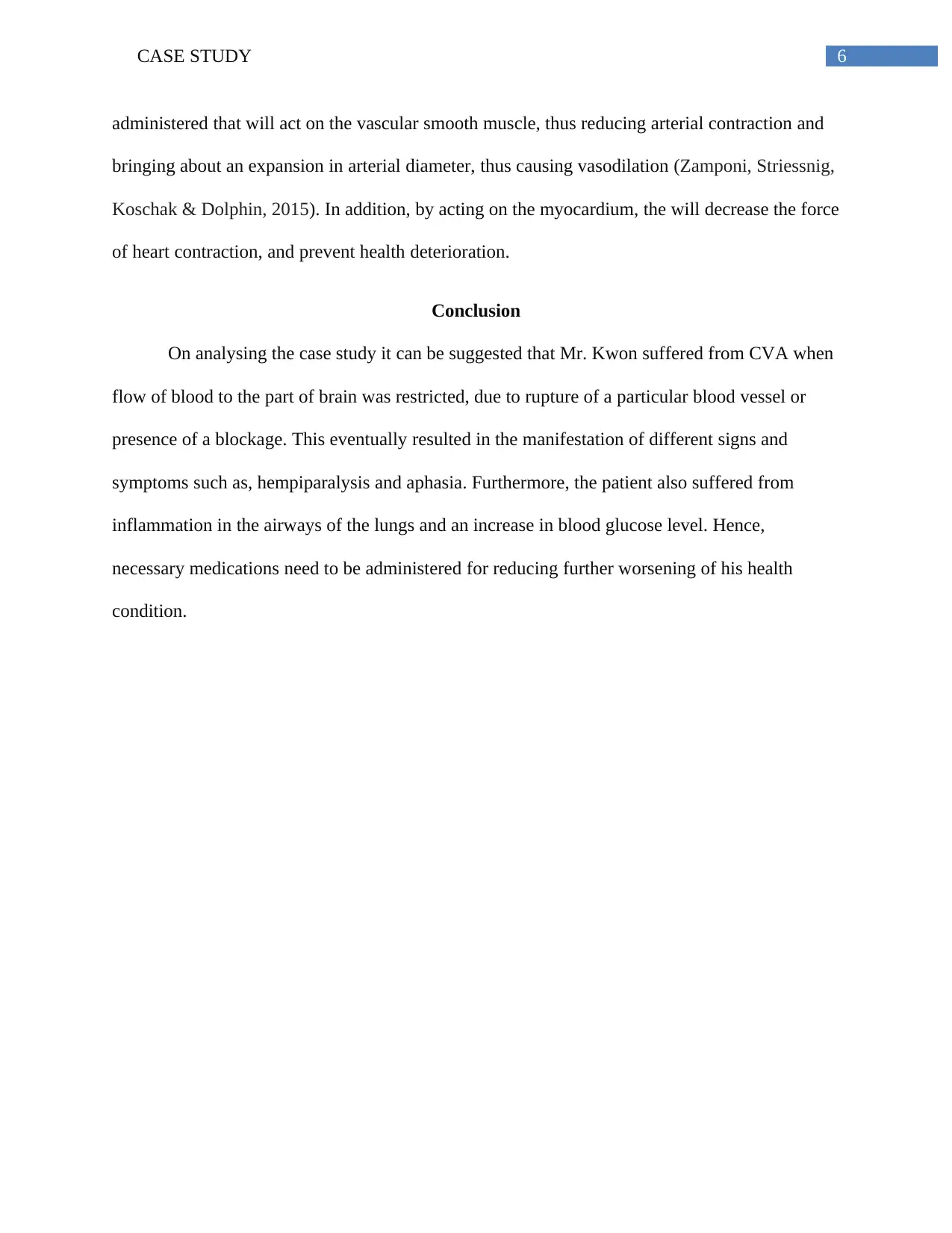
6CASE STUDY
administered that will act on the vascular smooth muscle, thus reducing arterial contraction and
bringing about an expansion in arterial diameter, thus causing vasodilation (Zamponi, Striessnig,
Koschak & Dolphin, 2015). In addition, by acting on the myocardium, the will decrease the force
of heart contraction, and prevent health deterioration.
Conclusion
On analysing the case study it can be suggested that Mr. Kwon suffered from CVA when
flow of blood to the part of brain was restricted, due to rupture of a particular blood vessel or
presence of a blockage. This eventually resulted in the manifestation of different signs and
symptoms such as, hempiparalysis and aphasia. Furthermore, the patient also suffered from
inflammation in the airways of the lungs and an increase in blood glucose level. Hence,
necessary medications need to be administered for reducing further worsening of his health
condition.
administered that will act on the vascular smooth muscle, thus reducing arterial contraction and
bringing about an expansion in arterial diameter, thus causing vasodilation (Zamponi, Striessnig,
Koschak & Dolphin, 2015). In addition, by acting on the myocardium, the will decrease the force
of heart contraction, and prevent health deterioration.
Conclusion
On analysing the case study it can be suggested that Mr. Kwon suffered from CVA when
flow of blood to the part of brain was restricted, due to rupture of a particular blood vessel or
presence of a blockage. This eventually resulted in the manifestation of different signs and
symptoms such as, hempiparalysis and aphasia. Furthermore, the patient also suffered from
inflammation in the airways of the lungs and an increase in blood glucose level. Hence,
necessary medications need to be administered for reducing further worsening of his health
condition.
Paraphrase This Document
Need a fresh take? Get an instant paraphrase of this document with our AI Paraphraser
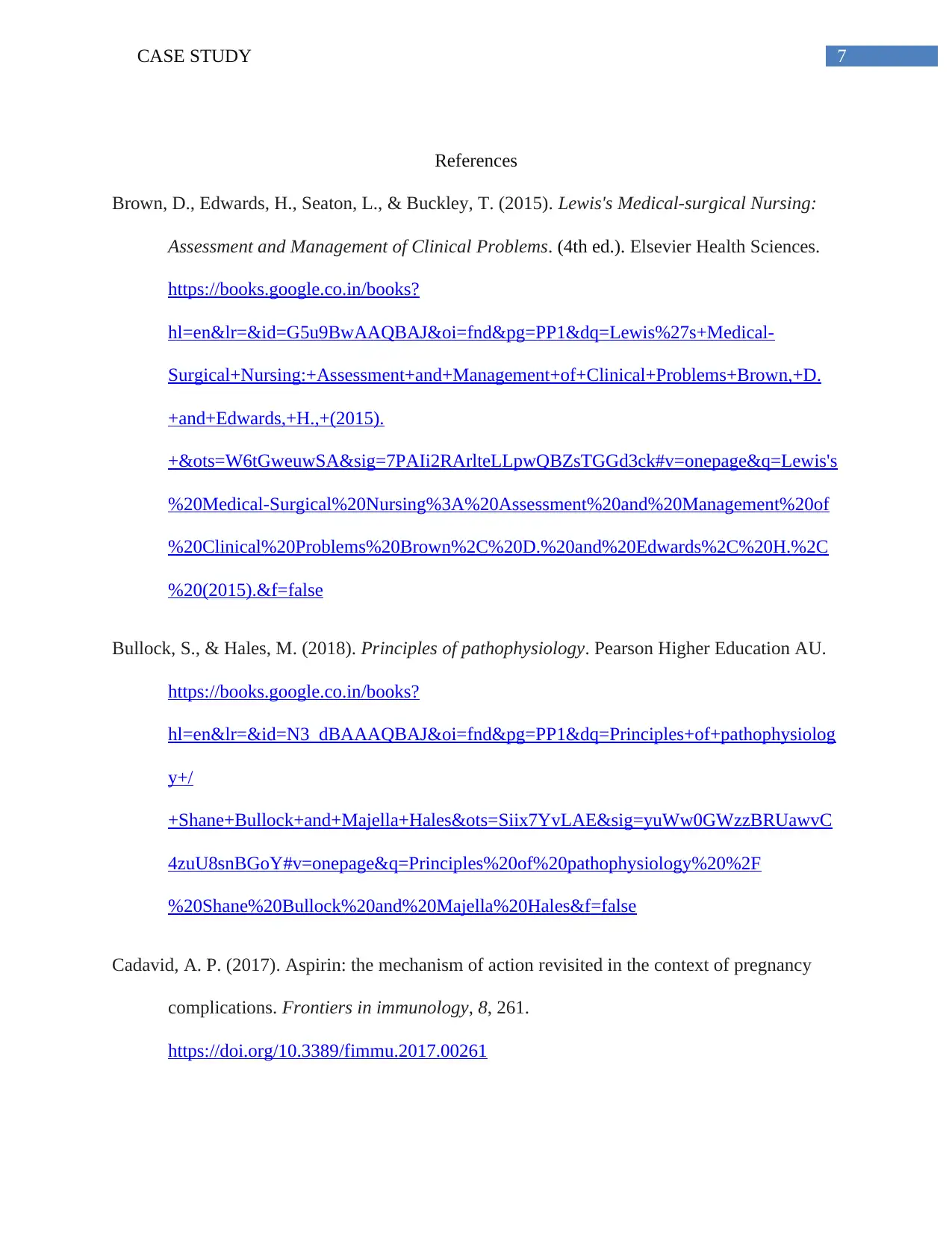
7CASE STUDY
References
Brown, D., Edwards, H., Seaton, L., & Buckley, T. (2015). Lewis's Medical-surgical Nursing:
Assessment and Management of Clinical Problems. (4th ed.). Elsevier Health Sciences.
https://books.google.co.in/books?
hl=en&lr=&id=G5u9BwAAQBAJ&oi=fnd&pg=PP1&dq=Lewis%27s+Medical-
Surgical+Nursing:+Assessment+and+Management+of+Clinical+Problems+Brown,+D.
+and+Edwards,+H.,+(2015).
+&ots=W6tGweuwSA&sig=7PAIi2RArlteLLpwQBZsTGGd3ck#v=onepage&q=Lewis's
%20Medical-Surgical%20Nursing%3A%20Assessment%20and%20Management%20of
%20Clinical%20Problems%20Brown%2C%20D.%20and%20Edwards%2C%20H.%2C
%20(2015).&f=false
Bullock, S., & Hales, M. (2018). Principles of pathophysiology. Pearson Higher Education AU.
https://books.google.co.in/books?
hl=en&lr=&id=N3_dBAAAQBAJ&oi=fnd&pg=PP1&dq=Principles+of+pathophysiolog
y+/
+Shane+Bullock+and+Majella+Hales&ots=Siix7YvLAE&sig=yuWw0GWzzBRUawvC
4zuU8snBGoY#v=onepage&q=Principles%20of%20pathophysiology%20%2F
%20Shane%20Bullock%20and%20Majella%20Hales&f=false
Cadavid, A. P. (2017). Aspirin: the mechanism of action revisited in the context of pregnancy
complications. Frontiers in immunology, 8, 261.
https://doi.org/10.3389/fimmu.2017.00261
References
Brown, D., Edwards, H., Seaton, L., & Buckley, T. (2015). Lewis's Medical-surgical Nursing:
Assessment and Management of Clinical Problems. (4th ed.). Elsevier Health Sciences.
https://books.google.co.in/books?
hl=en&lr=&id=G5u9BwAAQBAJ&oi=fnd&pg=PP1&dq=Lewis%27s+Medical-
Surgical+Nursing:+Assessment+and+Management+of+Clinical+Problems+Brown,+D.
+and+Edwards,+H.,+(2015).
+&ots=W6tGweuwSA&sig=7PAIi2RArlteLLpwQBZsTGGd3ck#v=onepage&q=Lewis's
%20Medical-Surgical%20Nursing%3A%20Assessment%20and%20Management%20of
%20Clinical%20Problems%20Brown%2C%20D.%20and%20Edwards%2C%20H.%2C
%20(2015).&f=false
Bullock, S., & Hales, M. (2018). Principles of pathophysiology. Pearson Higher Education AU.
https://books.google.co.in/books?
hl=en&lr=&id=N3_dBAAAQBAJ&oi=fnd&pg=PP1&dq=Principles+of+pathophysiolog
y+/
+Shane+Bullock+and+Majella+Hales&ots=Siix7YvLAE&sig=yuWw0GWzzBRUawvC
4zuU8snBGoY#v=onepage&q=Principles%20of%20pathophysiology%20%2F
%20Shane%20Bullock%20and%20Majella%20Hales&f=false
Cadavid, A. P. (2017). Aspirin: the mechanism of action revisited in the context of pregnancy
complications. Frontiers in immunology, 8, 261.
https://doi.org/10.3389/fimmu.2017.00261
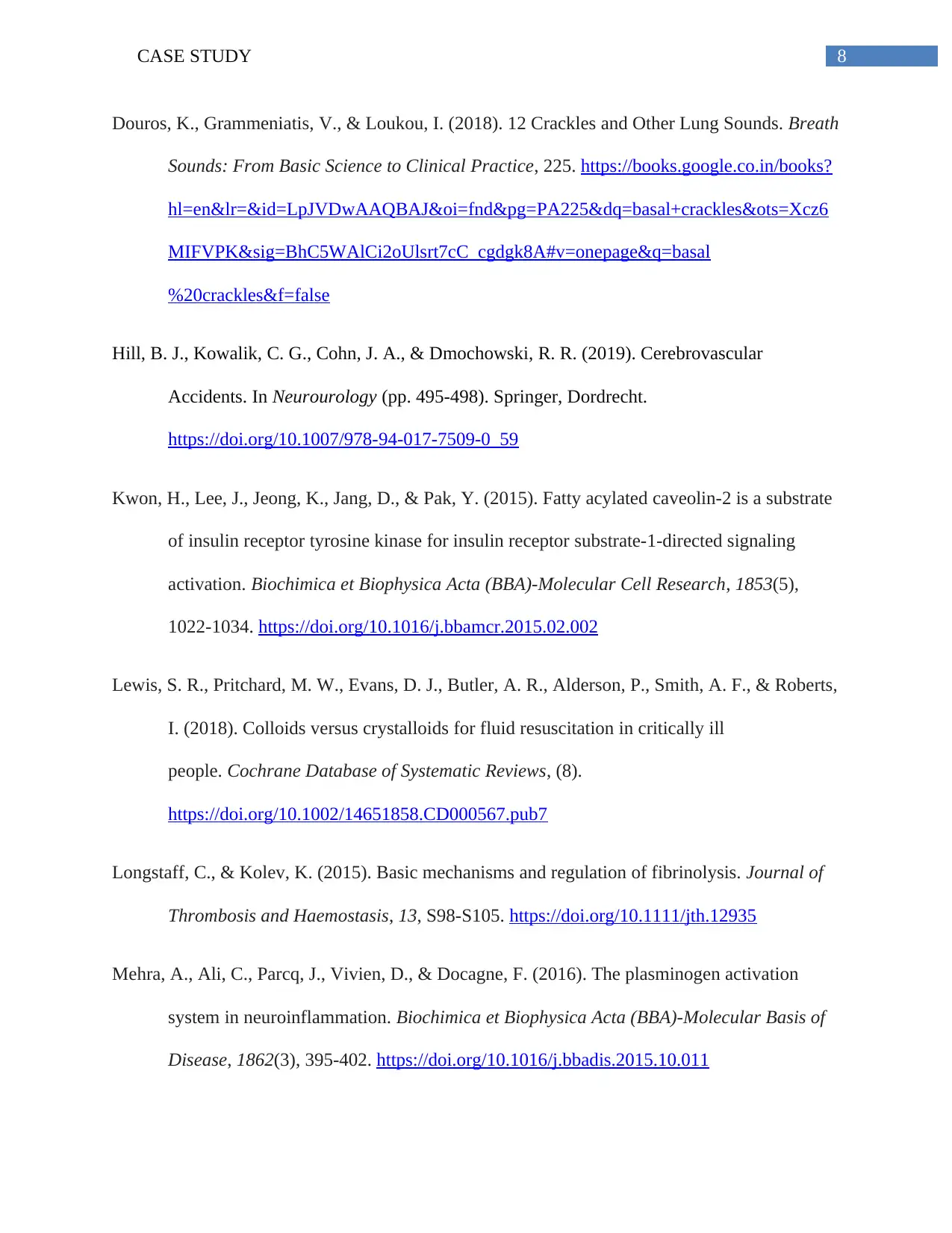
8CASE STUDY
Douros, K., Grammeniatis, V., & Loukou, I. (2018). 12 Crackles and Other Lung Sounds. Breath
Sounds: From Basic Science to Clinical Practice, 225. https://books.google.co.in/books?
hl=en&lr=&id=LpJVDwAAQBAJ&oi=fnd&pg=PA225&dq=basal+crackles&ots=Xcz6
MIFVPK&sig=BhC5WAlCi2oUlsrt7cC_cgdgk8A#v=onepage&q=basal
%20crackles&f=false
Hill, B. J., Kowalik, C. G., Cohn, J. A., & Dmochowski, R. R. (2019). Cerebrovascular
Accidents. In Neurourology (pp. 495-498). Springer, Dordrecht.
https://doi.org/10.1007/978-94-017-7509-0_59
Kwon, H., Lee, J., Jeong, K., Jang, D., & Pak, Y. (2015). Fatty acylated caveolin-2 is a substrate
of insulin receptor tyrosine kinase for insulin receptor substrate-1-directed signaling
activation. Biochimica et Biophysica Acta (BBA)-Molecular Cell Research, 1853(5),
1022-1034. https://doi.org/10.1016/j.bbamcr.2015.02.002
Lewis, S. R., Pritchard, M. W., Evans, D. J., Butler, A. R., Alderson, P., Smith, A. F., & Roberts,
I. (2018). Colloids versus crystalloids for fluid resuscitation in critically ill
people. Cochrane Database of Systematic Reviews, (8).
https://doi.org/10.1002/14651858.CD000567.pub7
Longstaff, C., & Kolev, K. (2015). Basic mechanisms and regulation of fibrinolysis. Journal of
Thrombosis and Haemostasis, 13, S98-S105. https://doi.org/10.1111/jth.12935
Mehra, A., Ali, C., Parcq, J., Vivien, D., & Docagne, F. (2016). The plasminogen activation
system in neuroinflammation. Biochimica et Biophysica Acta (BBA)-Molecular Basis of
Disease, 1862(3), 395-402. https://doi.org/10.1016/j.bbadis.2015.10.011
Douros, K., Grammeniatis, V., & Loukou, I. (2018). 12 Crackles and Other Lung Sounds. Breath
Sounds: From Basic Science to Clinical Practice, 225. https://books.google.co.in/books?
hl=en&lr=&id=LpJVDwAAQBAJ&oi=fnd&pg=PA225&dq=basal+crackles&ots=Xcz6
MIFVPK&sig=BhC5WAlCi2oUlsrt7cC_cgdgk8A#v=onepage&q=basal
%20crackles&f=false
Hill, B. J., Kowalik, C. G., Cohn, J. A., & Dmochowski, R. R. (2019). Cerebrovascular
Accidents. In Neurourology (pp. 495-498). Springer, Dordrecht.
https://doi.org/10.1007/978-94-017-7509-0_59
Kwon, H., Lee, J., Jeong, K., Jang, D., & Pak, Y. (2015). Fatty acylated caveolin-2 is a substrate
of insulin receptor tyrosine kinase for insulin receptor substrate-1-directed signaling
activation. Biochimica et Biophysica Acta (BBA)-Molecular Cell Research, 1853(5),
1022-1034. https://doi.org/10.1016/j.bbamcr.2015.02.002
Lewis, S. R., Pritchard, M. W., Evans, D. J., Butler, A. R., Alderson, P., Smith, A. F., & Roberts,
I. (2018). Colloids versus crystalloids for fluid resuscitation in critically ill
people. Cochrane Database of Systematic Reviews, (8).
https://doi.org/10.1002/14651858.CD000567.pub7
Longstaff, C., & Kolev, K. (2015). Basic mechanisms and regulation of fibrinolysis. Journal of
Thrombosis and Haemostasis, 13, S98-S105. https://doi.org/10.1111/jth.12935
Mehra, A., Ali, C., Parcq, J., Vivien, D., & Docagne, F. (2016). The plasminogen activation
system in neuroinflammation. Biochimica et Biophysica Acta (BBA)-Molecular Basis of
Disease, 1862(3), 395-402. https://doi.org/10.1016/j.bbadis.2015.10.011
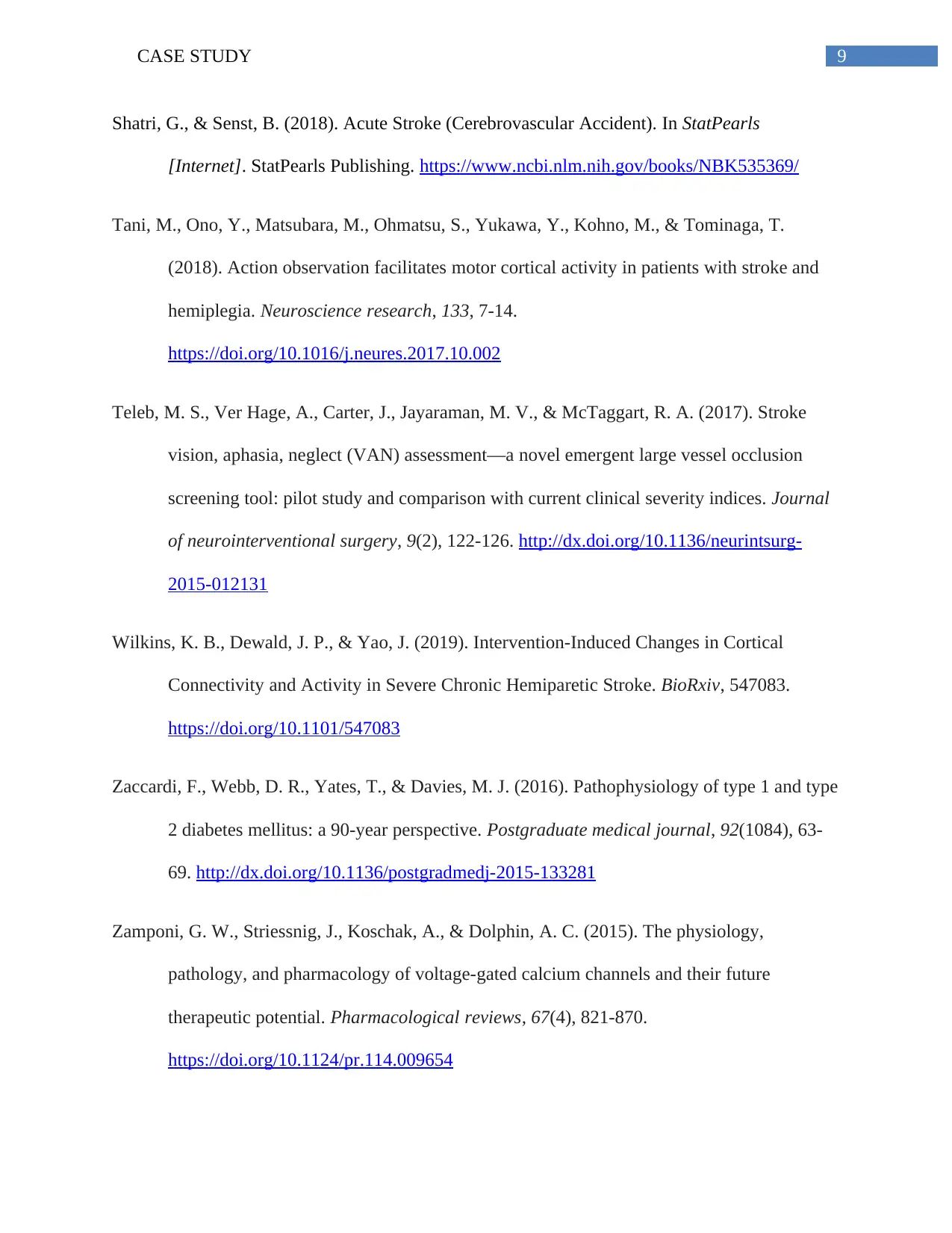
9CASE STUDY
Shatri, G., & Senst, B. (2018). Acute Stroke (Cerebrovascular Accident). In StatPearls
[Internet]. StatPearls Publishing. https://www.ncbi.nlm.nih.gov/books/NBK535369/
Tani, M., Ono, Y., Matsubara, M., Ohmatsu, S., Yukawa, Y., Kohno, M., & Tominaga, T.
(2018). Action observation facilitates motor cortical activity in patients with stroke and
hemiplegia. Neuroscience research, 133, 7-14.
https://doi.org/10.1016/j.neures.2017.10.002
Teleb, M. S., Ver Hage, A., Carter, J., Jayaraman, M. V., & McTaggart, R. A. (2017). Stroke
vision, aphasia, neglect (VAN) assessment—a novel emergent large vessel occlusion
screening tool: pilot study and comparison with current clinical severity indices. Journal
of neurointerventional surgery, 9(2), 122-126. http://dx.doi.org/10.1136/neurintsurg-
2015-012131
Wilkins, K. B., Dewald, J. P., & Yao, J. (2019). Intervention-Induced Changes in Cortical
Connectivity and Activity in Severe Chronic Hemiparetic Stroke. BioRxiv, 547083.
https://doi.org/10.1101/547083
Zaccardi, F., Webb, D. R., Yates, T., & Davies, M. J. (2016). Pathophysiology of type 1 and type
2 diabetes mellitus: a 90-year perspective. Postgraduate medical journal, 92(1084), 63-
69. http://dx.doi.org/10.1136/postgradmedj-2015-133281
Zamponi, G. W., Striessnig, J., Koschak, A., & Dolphin, A. C. (2015). The physiology,
pathology, and pharmacology of voltage-gated calcium channels and their future
therapeutic potential. Pharmacological reviews, 67(4), 821-870.
https://doi.org/10.1124/pr.114.009654
Shatri, G., & Senst, B. (2018). Acute Stroke (Cerebrovascular Accident). In StatPearls
[Internet]. StatPearls Publishing. https://www.ncbi.nlm.nih.gov/books/NBK535369/
Tani, M., Ono, Y., Matsubara, M., Ohmatsu, S., Yukawa, Y., Kohno, M., & Tominaga, T.
(2018). Action observation facilitates motor cortical activity in patients with stroke and
hemiplegia. Neuroscience research, 133, 7-14.
https://doi.org/10.1016/j.neures.2017.10.002
Teleb, M. S., Ver Hage, A., Carter, J., Jayaraman, M. V., & McTaggart, R. A. (2017). Stroke
vision, aphasia, neglect (VAN) assessment—a novel emergent large vessel occlusion
screening tool: pilot study and comparison with current clinical severity indices. Journal
of neurointerventional surgery, 9(2), 122-126. http://dx.doi.org/10.1136/neurintsurg-
2015-012131
Wilkins, K. B., Dewald, J. P., & Yao, J. (2019). Intervention-Induced Changes in Cortical
Connectivity and Activity in Severe Chronic Hemiparetic Stroke. BioRxiv, 547083.
https://doi.org/10.1101/547083
Zaccardi, F., Webb, D. R., Yates, T., & Davies, M. J. (2016). Pathophysiology of type 1 and type
2 diabetes mellitus: a 90-year perspective. Postgraduate medical journal, 92(1084), 63-
69. http://dx.doi.org/10.1136/postgradmedj-2015-133281
Zamponi, G. W., Striessnig, J., Koschak, A., & Dolphin, A. C. (2015). The physiology,
pathology, and pharmacology of voltage-gated calcium channels and their future
therapeutic potential. Pharmacological reviews, 67(4), 821-870.
https://doi.org/10.1124/pr.114.009654
Secure Best Marks with AI Grader
Need help grading? Try our AI Grader for instant feedback on your assignments.

10CASE STUDY
1 out of 11
Related Documents
Your All-in-One AI-Powered Toolkit for Academic Success.
+13062052269
info@desklib.com
Available 24*7 on WhatsApp / Email
![[object Object]](/_next/static/media/star-bottom.7253800d.svg)
Unlock your academic potential
© 2024 | Zucol Services PVT LTD | All rights reserved.





